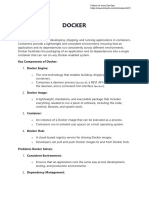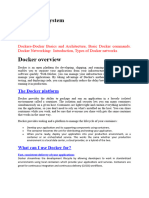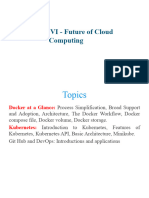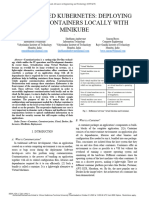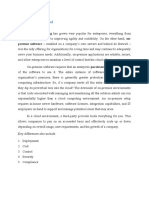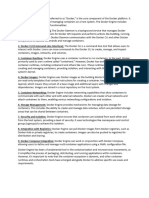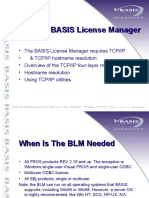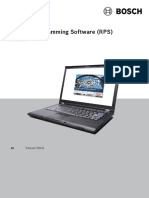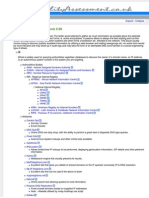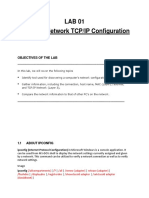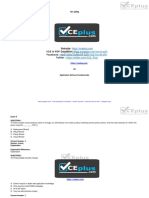9.
docker network: Manages Docker networks, allowing you to create, inspect, and remove
docker network [OPTIONS] COMMAND
10. docker volume: Manages Docker volumes, which are used for persisting data shared among
containers. You can create, inspect, and remove volumes.
docker volume [OPTIONS] COMMAND
11. docker-compose: This is a separate command-line tool for working with Docker Compose files
and managing multi-container applications. It provides commands for defining, building, and
deploying applications defined in `docker-compose.yml` files.
docker-compose [OPTIONS] COMMAND
12. docker login and docker logout: These commands allow you to log in and log out of Docker
registries to access private images or push images to registries.
docker login [OPTIONS] [SERVER]
docker logout [SERVER]
These are just a few examples of Docker CLI commands. The Docker CLI provides a wide range of
commands and options to manage containers and container-related resources effectively. You can
use the `docker --help` command or refer to Docker's documentation for a comprehensive list of
available commands and their usage.
Container Runtime:
A container runtime, sometimes simply referred to as a "container engine," is a software component
responsible for creating, managing, and running containers on a host operating system. Containers
are lightweight, portable, and isolated environments that package an application and its
dependencies, making it easy to deploy and run software consistently across different environments.
While Docker is perhaps the most well-known containerization platform, it's important to note that
there are other container runtimes available, including alternatives to Docker's runtime. Some
common container runtimes include:
1. Docker Engine: Docker's container runtime is known as Docker Engine. It consists of the Docker
daemon (`dockerd`) and the Docker CLI (`docker`), which work together to manage containers and
images. Docker Engine is widely used and has a vast ecosystem of tools and resources.
2. containerd: Containerd is an industry-standard core container runtime that was originally part of
the Docker project but has since been separated as an independent project under the Cloud Native
Computing Foundation (CNCF). It provides the basic functionalities for running containers and can be
used as a runtime for container orchestration platforms like Kubernetes.
3. rkt (pronounced "rocket"): rkt is a container runtime developed by CoreOS (now part of Red Hat)
with a focus on security and simplicity. rkt's design differs from Docker in some keyways, such as its
use of a pluggable architecture for image fetching and execution.
4. CRI-O: CRI-O is a lightweight, open-source container runtime developed primarily for Kubernetes.
It adheres to the Kubernetes Container Runtime Interface (CRI) standard, making it suitable for
running containers in Kubernetes clusters.
�5. container-native virtualization runtimes (e.g., runv, kata-runtime): These runtimes focus on
providing lightweight virtualization-based container runtimes for enhanced isolation and security.
They use technologies like Intel VT-x or AMD-V for virtualization.
6. Podman: Podman is an alternative container engine that provides a Docker-CLI-compatible
interface while aiming to address security concerns. It allows running containers as "pods," like
Kubernetes pods.
7. railcar: Railcar is another lightweight, security-focused container runtime that aims to be a more
minimal alternative to Docker.
The choice of a container runtime depends on various factors, including security requirements,
performance needs, compatibility with orchestration platforms, and personal or organizational
preferences. In many cases, Docker Engine remains a popular choice due to its maturity and broad
adoption, while other runtimes offer specialized features or address specific use cases.
It's important to note that container runtimes are often components of a larger container ecosystem,
which may include container orchestration platforms (e.g., Kubernetes, Docker Swarm), container
registries (e.g., Docker Hub), and container management and monitoring tools. The choice of
container runtime should align with the overall container strategy and architecture of an
organization.
Docker Images:
A Docker image is a lightweight, stand-alone, executable package that includes everything needed to
run a piece of software, including the code, a runtime, system tools, libraries, and settings. Docker
images serve as the blueprint or template for creating Docker containers. They are a fundamental
building block in the world of containerization and are at the core of the Docker platform.
Here are key characteristics and components of Docker images:
1. Immutable: Docker images are designed to be immutable, meaning they are read-only and cannot
be modified once created. Any changes to the software or its configuration result in the creation of a
new image with a new version.
2. Layered Filesystem: Docker images are composed of layers. Each layer represents a set of changes
to the filesystem, such as adding or modifying files. Layers are stacked on top of each other, and this
layered filesystem allows for efficient storage and sharing of images. When you build a new image,
Docker only adds or modifies the necessary layers, which makes image distribution and updates
efficient.
3. Dockerfile: To create a Docker image, you typically start with a Dockerfile, which is a text file that
contains a series of instructions for building the image. Dockerfiles specify the base image, add files
and directories, set environment variables, and configure the image to run the desired software.
4. Base Images: Docker images are often based on existing base images, which serve as the starting
point for creating custom images. Base images are typically minimal and contain a basic operating
system and runtime environment.
�5. Versioning: Docker images are versioned using tags. Tags are user-defined labels attached to
images to differentiate between different versions or configurations of an image. For example, you
might have an image with the tag "v1.0" and another with "v2.0."
6. Docker Registry: Docker images can be stored in Docker registries, which are centralized
repositories for sharing and distributing Docker images. Docker Hub is a popular public registry, and
organizations often set up their private registries for security and control.
7. Caching: Docker employs a caching mechanism during image builds. If an instruction in a
Dockerfile has not changed, Docker can reuse previously built layers, which speeds up the image-
building process.
8. Layer Reusability: Layers in Docker images are designed to be reusable across multiple images.
This means that if multiple images share the same layers (e.g., a common base image), the storage
requirements are reduced as those layers are shared.
Using Docker images, developers can package applications and their dependencies in a consistent
and reproducible way. This consistency makes it easy to develop, test, and deploy software across
different environments, from development laptops to production servers. Docker images have
become a standard format for distributing and deploying containerized applications, facilitating the
adoption of containerization and microservices architectures in software development.
Containers Networking:
Container networking refers to the set of technologies and techniques used to enable
communication between containers running on the same or different hosts within a containerized
environment. Effective container networking is essential for building and deploying microservices-
based applications, orchestrating containers, and ensuring seamless communication between
containerized components.
Here are some key concepts and aspects related to container networking:
1. Network Namespace: In Linux, each container runs in its own network namespace. This means
that containers are isolated from the host and other containers, and they have their own network
stack, including network interfaces, IP addresses, and routing tables.
2. Bridge Networks: By default, Docker creates a bridge network for containers on a host. Containers
connected to the same bridge network can communicate with each other directly using their internal
IP addresses. Docker creates a virtual Ethernet bridge (e.g., `docker0`) to facilitate this
communication.
3. Host Networking: Containers can also use the host network, which means they share the same
network namespace as the host. This allows containers to bind to host ports and have direct access
to the host's network stack. Host networking is useful for scenarios where you want containers to
have full access to the host's network, such as for performance-critical workloads.
4. Overlay Networks: Overlay networks are used for communication between containers running on
different hosts in a cluster or swarm. Technologies like VXLAN or IPSec are used to create virtual
�networks that span multiple hosts. Docker Swarm and Kubernetes often use overlay networks for
cross-host communication.
5. Container Ports: Containers can expose specific ports to the host or to other containers. This is
done using port mapping, where a port on the host is mapped to a port in the container. Containers
can then communicate over these exposed ports.
6. Service Discovery: Container orchestrators like Docker Swarm and Kubernetes provide built-in
service discovery mechanisms. They allow containers to discover and communicate with each other
using service names instead of IP addresses, making it easier to build and manage microservices-
based applications.
7. DNS Resolution: Containers often use DNS for name resolution. DNS servers are typically provided
by the container runtime or the container orchestrator. Containers can resolve the names of other
containers or external services using DNS.
8. Ingress and Load Balancing: In a containerized environment, ingress controllers and load
balancers play a crucial role in routing incoming traffic to the appropriate containers or services. They
distribute traffic based on rules, balancing the load across containers.
9. Security: Network security is a critical consideration in container networking. Container runtimes
and orchestrators provide security features like network policies and network segmentation to
control traffic between containers and enforce security rules.
10. Service Mesh: In complex microservices architectures, service mesh technologies like Istio and
Linkerd provide advanced networking features such as traffic management, security, observability,
and resilience. They can enhance the control and visibility of container-to-container communication.
11. Multicast and Broadcast: Some network protocols, such as multicast and broadcast, may not
work as expected within containerized environments due to network isolation. Special considerations
and configurations may be needed to support these protocols.
Container networking is a foundational aspect of container orchestration and microservices
architecture. Effective networking solutions help containers communicate efficiently and securely,
making it possible to build distributed applications that are scalable, resilient, and easy to manage.
Container orchestrators and runtime environments offer various features and configurations to
address the diverse networking needs of containerized workloads.
Storage Management:
Docker storage management involves efficiently managing storage resources within Docker
containers and the Docker environment. Effective Docker storage management ensures that
containers have access to the storage they need while optimizing resource utilization, data
persistence, and data security. Here are key considerations and practices related to Docker storage
management:
1. Docker Data Storage Drivers:
- Docker provides different storage drivers (or backends) to interact with the host's storage
subsystem. Common storage drivers include Overlay2, aufs, Device Mapper, and VFS. The choice of
storage driver can impact performance, compatibility, and storage features.
�2. Storage Volumes:
- Use Docker volumes to persist data and share it between containers. Volumes are separate from
the container's filesystem and can be mounted into one or more containers. They are the
recommended way to handle data that needs to persist across container restarts or be shared among
multiple containers.
- Create named volumes for easy management and data reuse.
3. Bind Mounts:
- Bind mounts allow you to mount a directory or file from the host machine into the container. This
is useful for sharing host system data with containers or accessing external storage.
4. Anonymous Volumes:
- Anonymous volumes are created automatically by Docker and are associated with a specific
container. They are suitable for temporary storage, but their data is not easily accessible outside the
container.
5. Data Containers:
- Data containers are specialized containers created solely for the purpose of holding data volumes.
While less commonly used than named volumes, data containers can provide a means to manage
data in older Docker environments.
6. Storage Plugins:
- Docker supports storage plugins that allow integration with various storage systems, including
network-attached storage (NAS), network file systems (NFS), and cloud-based storage solutions.
These plugins enable more advanced storage capabilities.
7. Docker Compose for Volumes:
- When using Docker Compose to manage multi-container applications, define volumes in the
Compose file to ensure that data is persisted consistently across service restarts.
8. Volume Backups and Restoration:
- Implement backup and restoration strategies for data stored in volumes. Regularly back up
important data and ensure that you can restore it if needed.
9. Storage Optimization:
- Optimize storage usage by cleaning up unused containers, volumes, and images. Use the `docker
system prune` command to remove dangling images, stopped containers, and unused volumes.
10. Monitoring and Logging:
- Monitor storage usage within containers and logs for storage-related issues. Pay attention to
storage-related alerts and errors in Docker logs.
11. Security:
- Implement access controls and encryption to protect sensitive data stored within containers or
volumes.



























